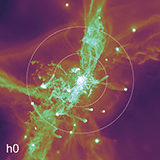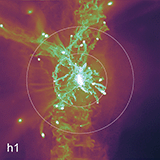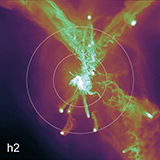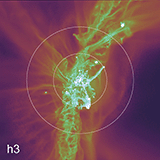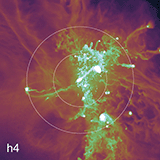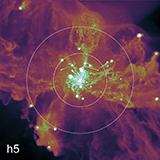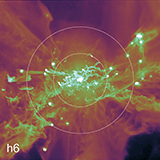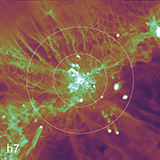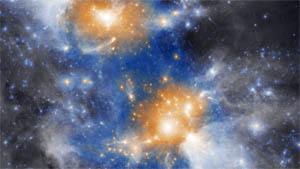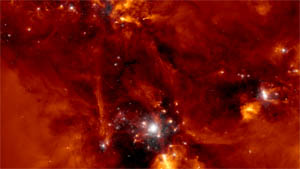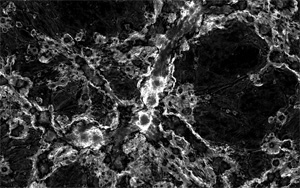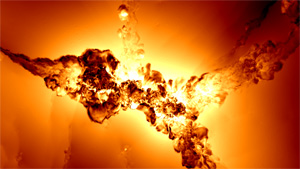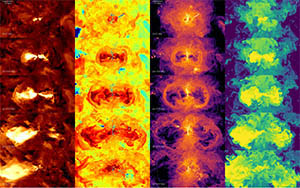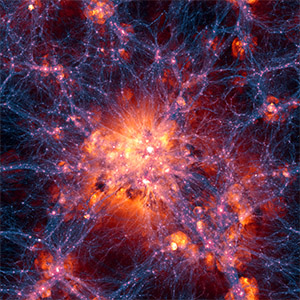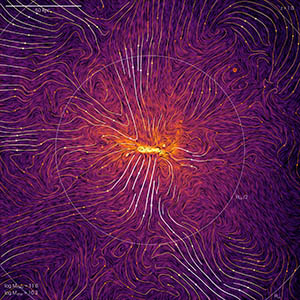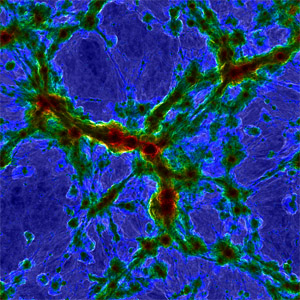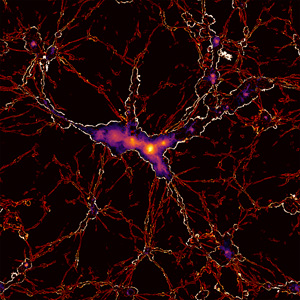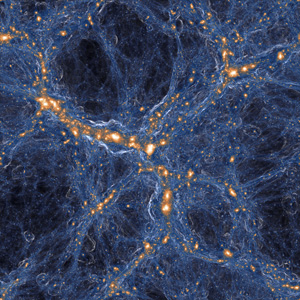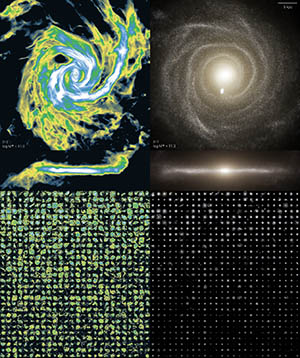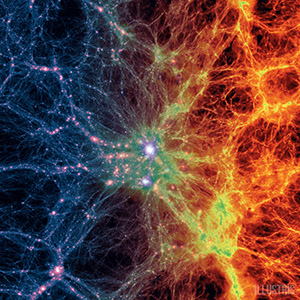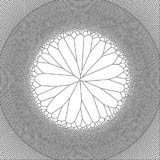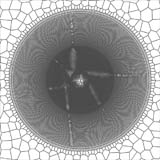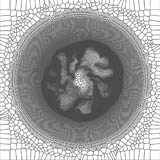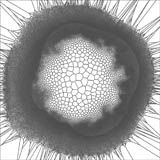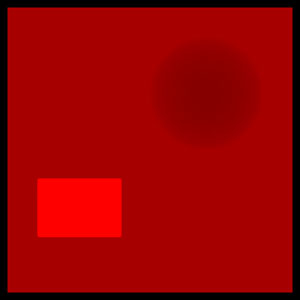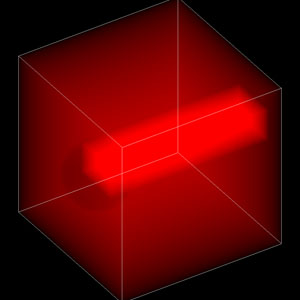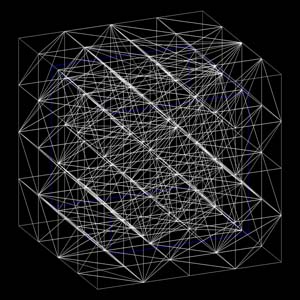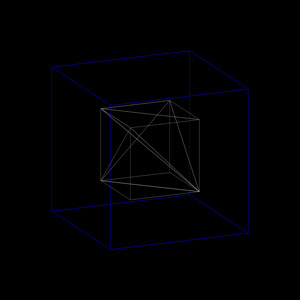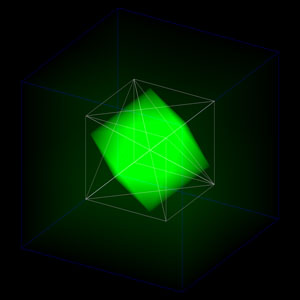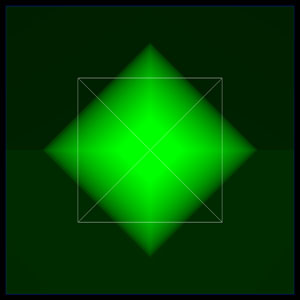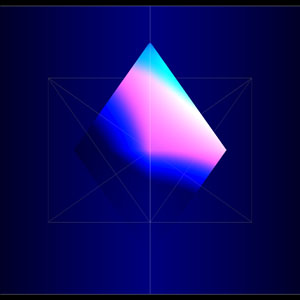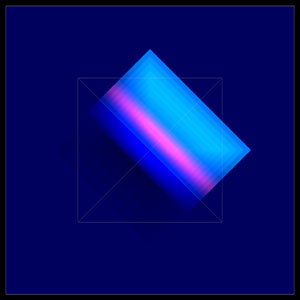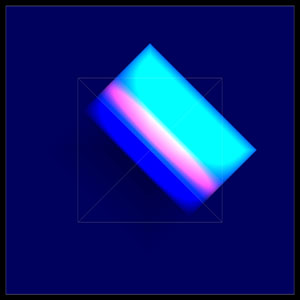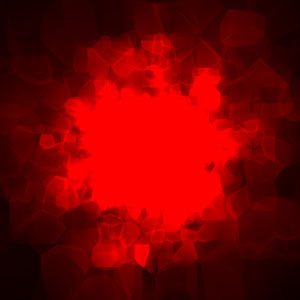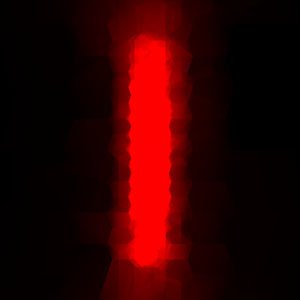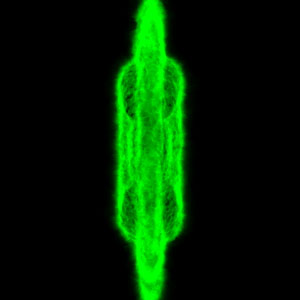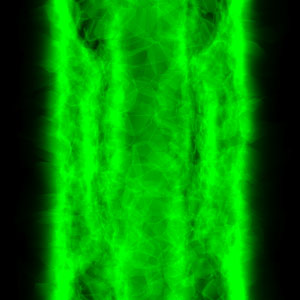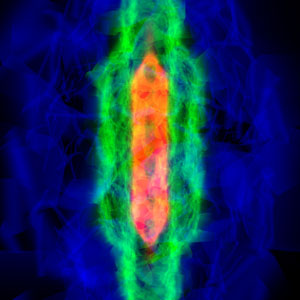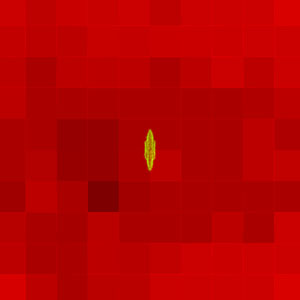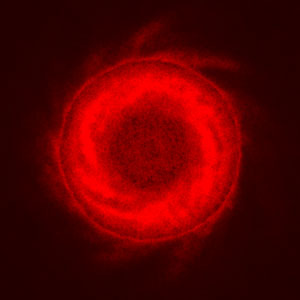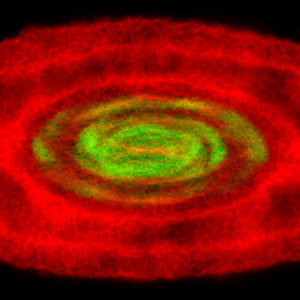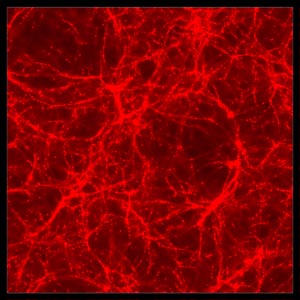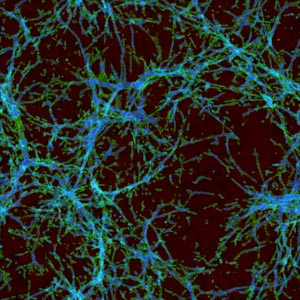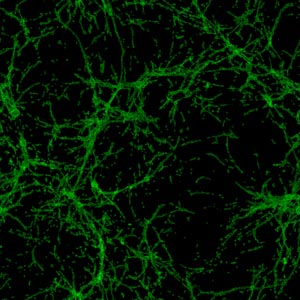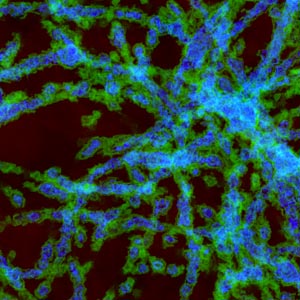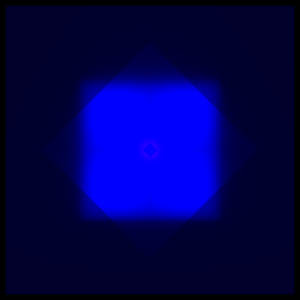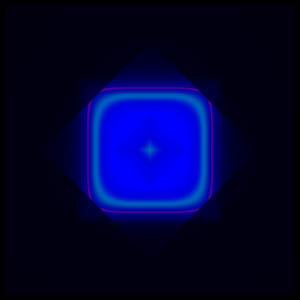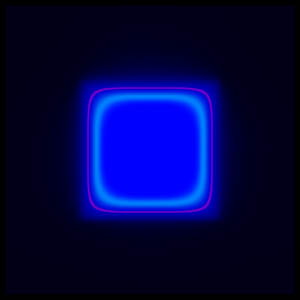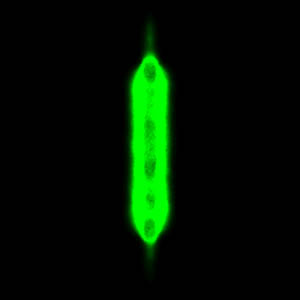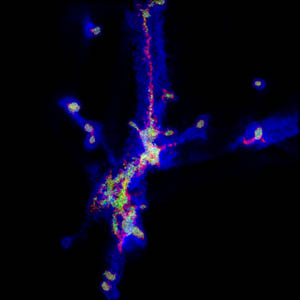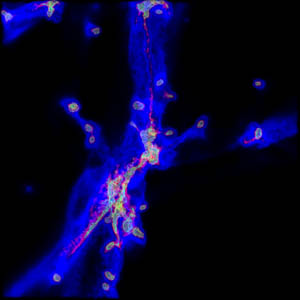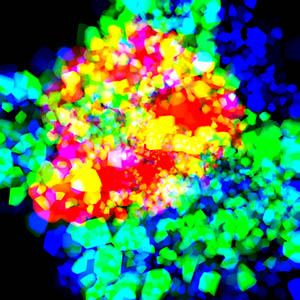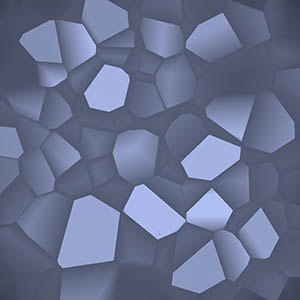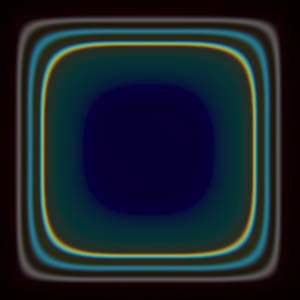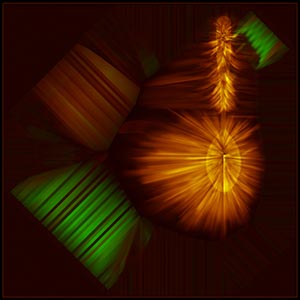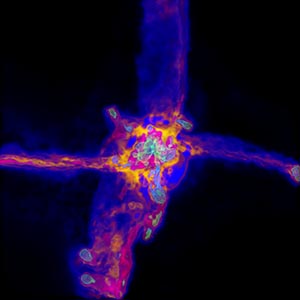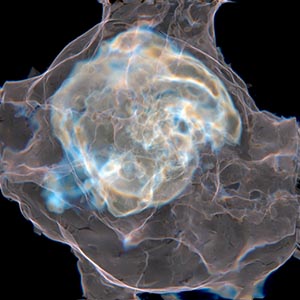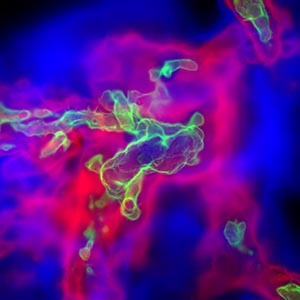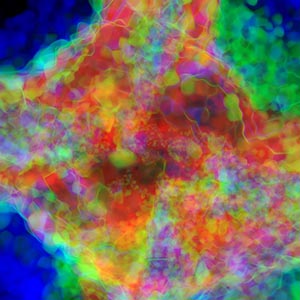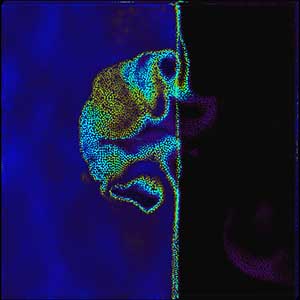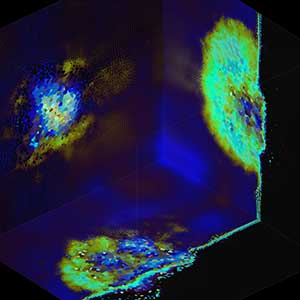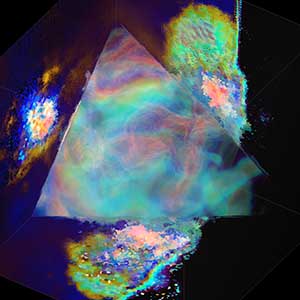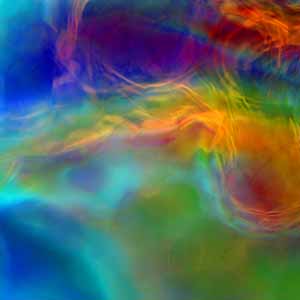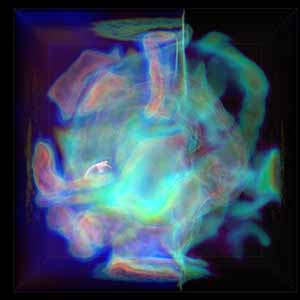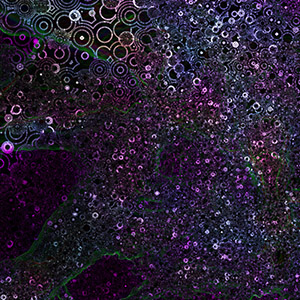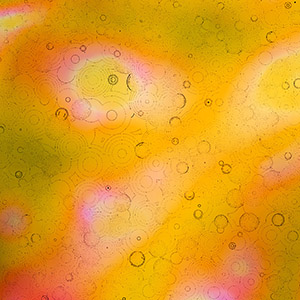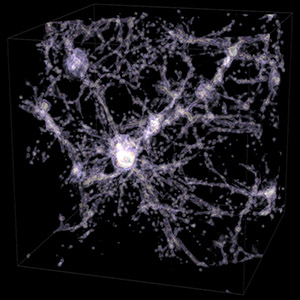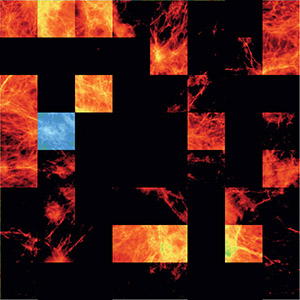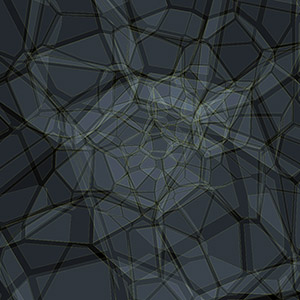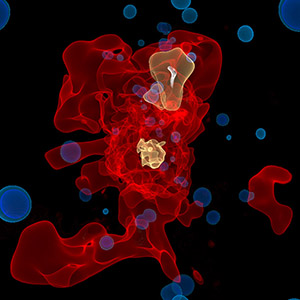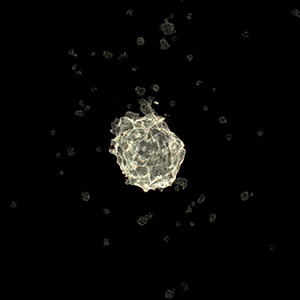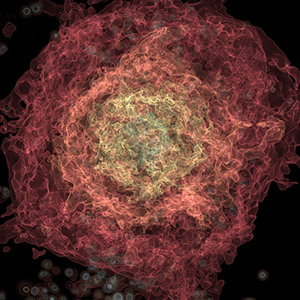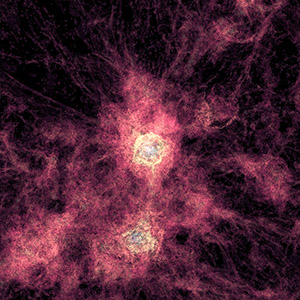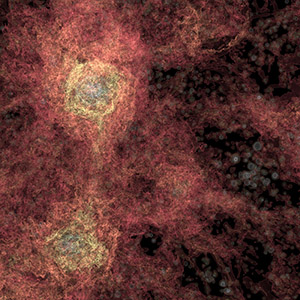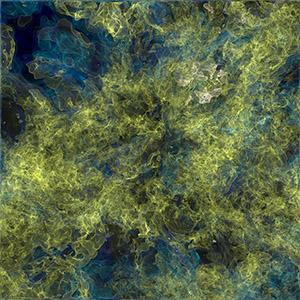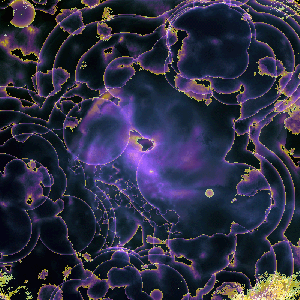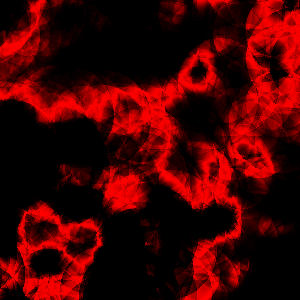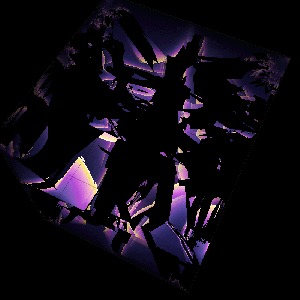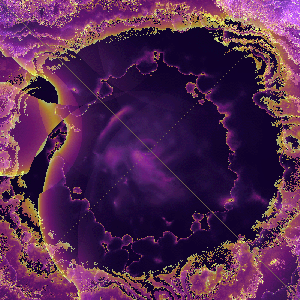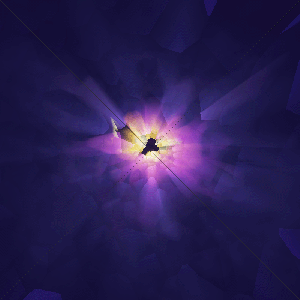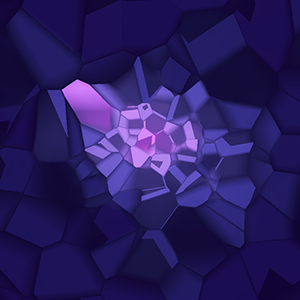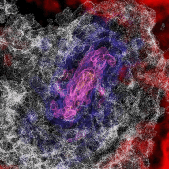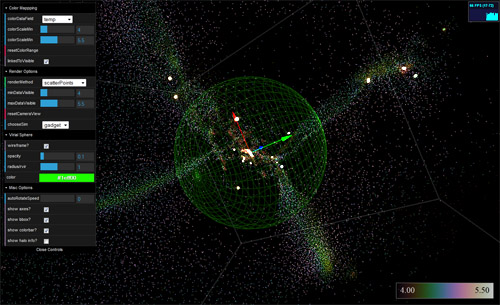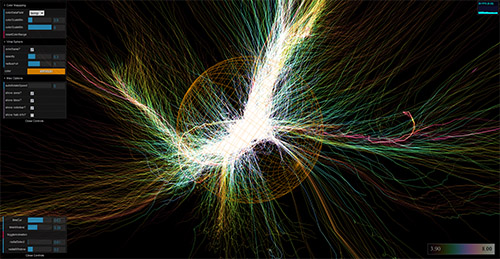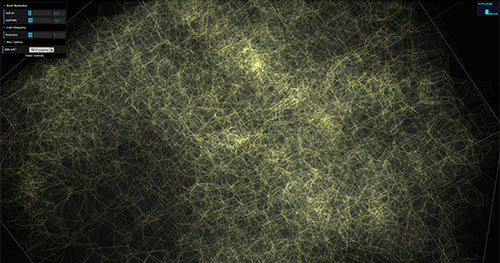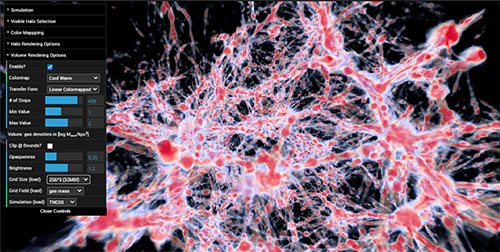Hello,
My name is Dylan Nelson. I am currently an Emmy Noether Research Group Leader at the Institute for Theoretical Astrophysics, within the Center for Astrophysics (ITA/ZAH) of Heidelberg University, Germany.
Previously I was a postdoctoral fellow at the Max Planck Institute for Astrophysics (MPA) in Munich, Germany. I completed my PhD in astrophysics at the Center for Astronomy (CfA) at Harvard University, working with Lars Hernquist. My research focus is developing and analyzing theoretical (computational) models of galaxy formation and evolution, with an emphasis on cosmic gas: cosmological gas accretion, the circumgalactic medium, the baryon cycle, and energetic feedback processes.
I study these problems through numerical simulations run with AREPO, a finite volume hydrodynamics code based on a moving unstructured mesh. I am a leader of the IllustrisTNG Project, and Co-PI of TNG50: next-generation large-volume cosmological magnetohydrodynamical simulations of galaxy and large-scale structure formation. I am also Co-PI of the new TNG-Cluster simulation of high-mass galaxy clusters. Previously, I contributed to the Illustris Simulation, the predecessor of TNG.
Recent, group-led simulation projects include: cosmosTNG, GIBLE, and TNG+CRs.
Herein you will find a further description of our group, my research interests, more technical projects, some visualization and WebGL experiments, my CV, including online talks, and contact information.
Welcome,
Dylan

Contact
Side Projects
group
Current Group Members:
Our research group is funded by the German Research Foundation (DFG) through the Emmy Noether program since 2020, as well as with support from the Hector Fellow Academy since 2021, the MERAC Foundation since 2023, and the STRUCTURES Cluster of Excellence since 2024.
Dylan Nelson
Group Leader
Chris Byrohl
Postdoc
Katrin Lehle
PhD Student
Raphael King
MSc Student
Jan Bergmann
MSc Student
Julian Saling
MSc Student
Lucas Schleuss
BSc Student
Jonas Spreng
BSc Student
Linn Kantseva
BSc Student
Jonas Biba
BSc Student
Jeremias Boucsein
BSc Student
Interested in joining the group?
... as a PhD student? The primary application is through IMPRS Heidelberg (deadline each year in November). In this case all advisors in Heidelberg University as well as MPIA will simultaneously be able to see your application.
... as a postdoctoral researcher? A number of opportunities exist where you can submit a proposal to fund yourself in Germany. Top options are through the Humboldt Foundation, with the Marie Sklodowska-Curie program, or through several funding programs of the German Research Foundation (DFG).
... for a bachelors or masters thesis on computational galaxy formation? Please get in touch! There are always projects available for highly motivated students.
Former Group Members:
Rahul Ramesh
PhD Student
--> Postdoc @ IPMU
Milan Staffehl
MSc Student (2023-24)
--> PhD @ Bonn
Reza Ayromlou
Postdoc
--> Argelander Fellow @ Bonn
Emma Gerakaki
BSc Student
--> Intern @ Porto
Eshna Roy
DAAD-WISE
Summer Intern (2024)
Ole Wittig
BSc Student
(2023-24)
Qi Guo
Summer Intern (2024)
--> PhD @ IPMU
Fin Taylor
MSc Student (2023)
Faizan Ahmad
Summer Intern (2023)
--> PhD @ Stuttgart
Samridh Singh
Summer Intern
(2023)
Nick Andreadis
MSc Student (2022-2023)
--> PhD @ Ghent
Xeno Boecker
BSc Student (2022-2023)
--> MSc @ Cologne
Katie Brown
DAAD-RISE Intern (2022)
--> PhD @ Stanford
Ema Zavodnik
BSc Student
(2022)
research
My scientific research interests fall into four main categories:
- The circumgalactic medium -- structure and origin, the impact of feedback, and observational signatures.
- Presenting IllustrisTNG, TNG50, and TNG-Cluster -- the next generation of magnetohydrodynamical cosmological simulations.
- Paper series: Zooming in on the CGM and Project GIBLE -- high-resolution studies of hot halos, filaments, inflows and outflows.
- Tracing Cosmological gas accretion -- how do galaxies get their gas? Cold vs. hot mode accretion and the baryon cycle.
Below you can find some highlights and the relevant papers from each topic.
1. The circumgalactic medium
The CGM in emission: MgII halos, and resonant scattering of OVII X-ray line
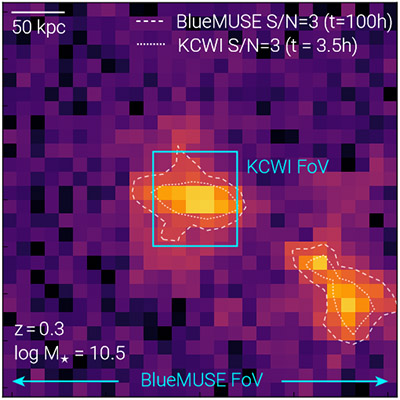
[arxiv] We outline theoretical predictions for extended emission from MgII, tracing cool ~104 K gas in the circumgalactic medium (CGM) of star-forming galaxies in the high-resolution TNG50 cosmological magnetohydrodynamical simulation. We synthesize surface brightness maps of this strong rest-frame ultraviolet metal emission doublet (2796, 2803), adopting the assumption that the resonant scattering of MgII can be neglected and connecting to recent and upcoming observations with the Keck/KCWI, VLT/MUSE, and BlueMUSE optical integral field unit spectrographs. Studying galaxies with stellar masses 7.5 < log(M*/M_sun) < 11 at redshifts z=0.3, 0.7, 1 and 2 we find that extended MgII halos in emission, similar to their Lyman-alpha counterparts, are ubiquitous across the galaxy population. Median surface brightness profiles exceed 10-19 erg/s/cm^2/arcsec^2 in the central ~10s of kpc, and total halo MgII luminosity increases with mass for star-forming galaxies, reaching 1040 erg/s for M* ~ 109.5 Msun. MgII halo sizes increase from a few kpc to > 20 kpc at the highest masses, and sizes are larger for halos in denser environments. MgII halos are highly structured, clumpy, and asymmetric, with isophotal axis ratio increasing with galaxy mass. Similarly, the amount and distribution of MgII emission depends on the star formation activity of the central galaxy. Kinematically, inflowing versus outflowing gas dominates the MgII luminosity at high and low galaxy masses, respectively, although the majority of MgII halo emission at z~0.7 traces near-equilibrium fountain flows and gas with non-negligible rotational support, rather than rapidly outflowing galactic winds.
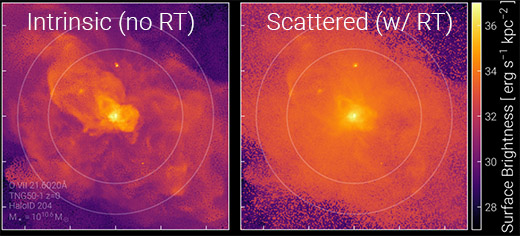
[arxiv] We study the impact of resonantly scattered X-ray line emission on the observability of the hot circumgalactic medium (CGM) of galaxies. We apply a Monte Carlo radiative transfer post-processing analysis to the high-resolution TNG50 cosmological magnetohydrodynamical galaxy formation simulation. This allows us to model the resonant scattering of OVII(r) X-ray photons within the complex, multi-phase, multi-scale CGM. The resonant transition of the OVII He-like triplet is one of the brightest, and most promising, X-ray emission lines for detecting the hot CGM and measuring its physical properties. We focus on galaxies with stellar masses 10 > log(M*/Msun) > 11 at z ~ 0. After constructing a model for OVII(r) emission from the central galaxy as well as from CGM gas, we forward model these intrinsic photons to derive observable surface brightness maps. We find that scattering significantly boosts the observable OVII(r) surface brightness of the extended and diffuse CGM. This enhancement can be large -- an order of magnitude on average at a distance of 200 projected kpc for high-mass M* = 1010.7 Msun galaxies. The enhancement is larger for lower mass galaxies, and can even reach a factor of 100, across the extended CGM. Galaxies with higher star formation rates, AGN luminosities, and central OVII(r) luminosities all have larger scattering enhancements, at fixed stellar mass. Our results suggest that next-generation X-ray spectroscopic missions including XRISM, LEM, ATHENA, and HUBS -- which aim to detect the hot CGM in emission -- could specifically target halos with significant enhancements due to resonant scattering.
Resolving small-scale cold circumgalatic gas in TNG50
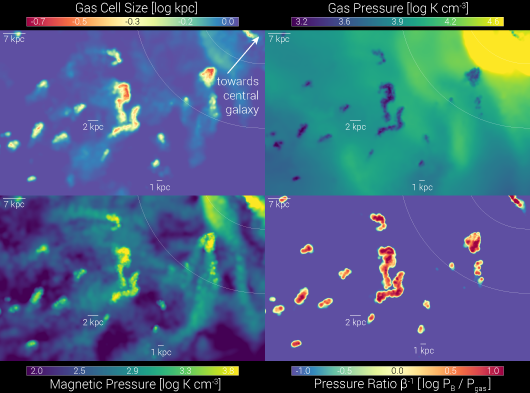
[arXiv] We use the high-resolution TNG50 cosmological magnetohydrodynamical simulation to explore the properties and origin of cold circumgalactic medium (CGM) gas around massive galaxies (M* > 1011 Msun) at intermediate redshift (z~0.5). We discover a significant abundance of small-scale, cold gas structure in the CGM of 'red and dead' elliptical systems, as traced by neutral HI and MgII. Halos can host tens of thousands of discrete absorbing cloudlets, with sizes of order a kpc or smaller.
With a Lagrangian tracer analysis, we show that cold clouds form due to strong ∂ρ/ρ >> 1 gas density perturbations which stimulate thermal instability. These local overdensities trigger rapid cooling from the hot virialized background medium at ~107 K to radiatively inefficient ~104 K clouds, which act as cosmologically long-lived, 'stimulated cooling' seeds in a regime where the global halo does not satisfy the classic tcool/tff < 10 criterion. Furthermore, these small clouds are dominated by magnetic rather than thermal pressure, with plasma β << 1, suggesting that magnetic fields may play an important role. The number and total mass of cold clouds both increase with resolution, and the ~8x104 Msun cell mass of TNG50 enables the ~few hundred pc, small-scale CGM structure we observe to form.
Finally, we contrast against observations from the COS-LRG, LRG-RDR, COS-Halos, and SDSS LRG surveys. We broadly find that our recent, high-resolution cosmological simulations produce sufficiently high covering fractions of extended, cold gas as observed to surround massive galaxies.
The abundance, distribution, and physical nature of highly ionized oxygen OVI, OVII, and OVIII in IllustrisTNG
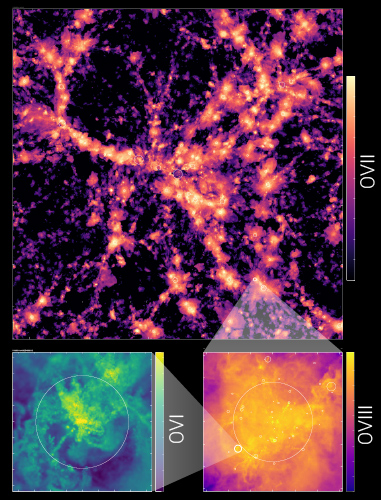
[arXiv] We explore the abundance, spatial distribution, and physical properties of the OVI, OVII, and OVIII ions of oxygen in circumgalactic and intergalactic media (the CGM, IGM, and WHIM). We use the TNG100 and TNG300 large volume cosmological magneto-hydrodynamical simulations. Modeling the ionization states of simulated oxygen, we find good agreement with observations of the low-redshift OVI column density distribution function (CDDF), and present its evolution for all three ions from z=0 to z=4. Producing mock quasar absorption line spectral surveys, we show that the IllustrisTNG simulations are fully consistent with constraints on the OVI content of the CGM from COS-Halos and other low redshift observations, producing columns as high as observed.
We measure the total amount of mass and average column densities of each ion using hundreds of thousands of simulated galaxies spanning 1011 < Mhalo/Msun < 1015 corresponding to 109 < M*/Msun < 1012 in stellar mass. The stacked radial profiles of OVI around halos of different masses are computed in 3D number density as well as 2D projected column, decomposing into the 1-halo and 2-halo terms, the latter of which begins to dominate for Milky Way mass halos in the WHIM just beyond the virial radius.
Relating halo OVI to properties of the central galaxy, we find a correlation between the (g-r) color of a galaxy and the total amount of OVI in its CGM. In comparison to the COS-Halos finding, this leads to a dichotomy of columns around star-forming versus passive galaxies at fixed stellar (or halo) mass. We demonstrate that this correlation is a direct result of blackhole feedback associated with quenching, which also produces additional trends with other galaxy properties, and represents a causal consequence of galactic-scale baryonic feedback impacting the physical state of the circumgalactic medium.
2. The IllustrisTNG Simulation Project, TNG50, and TNG-Cluster
Introducing TNG-Cluster: overview and physical properties of the gaseous intracluster medium
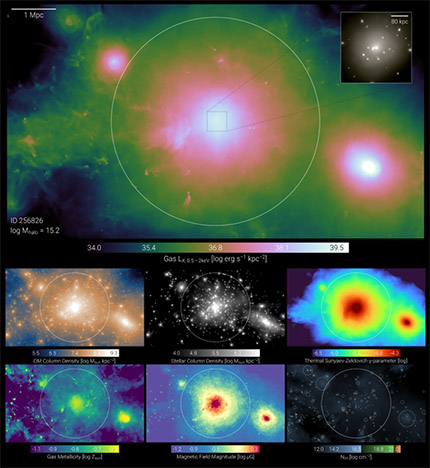
[arXiv] We introduce the new TNG-Cluster project, an addition to the IllustrisTNG suite of cosmological magnetohydrodynamical simulations of galaxy formation. Our objective is to significantly increase the statistical sampling of the most massive and rare objects in the Universe: galaxy clusters with log(M200c / Msun) > 14.3 - 15.4 at z=0. To do so, we re-simulate 352 cluster regions drawn from a 1 Gpc volume, thirty-six times larger than TNG300, keeping entirely fixed the IllustrisTNG physical model as well as the numerical resolution. This new sample of hundreds of massive galaxy clusters enables studies of the assembly of high-mass ellipticals and their supermassive black holes (SMBHs), brightest cluster galaxies (BCGs), satellite galaxy evolution and environmental processes, jellyfish galaxies, intracluster medium (ICM) properties, cooling and active galactic nuclei (AGN) feedback, mergers and relaxedness, magnetic field amplification, chemical enrichment, and the galaxy-halo connection at the high-mass end, with observables from the optical to radio synchrotron and the Sunyaev-Zeldovich (SZ) effect, to X-ray emission, as well as their cosmological applications. We present an overview of the simulation, the cluster sample, selected comparisons to data, and a first look at the diversity and physical properties of our simulated clusters and their hot ICM.
First results from the TNG50 simulation: Galactic outflows driven by supernovae and blackhole feedback
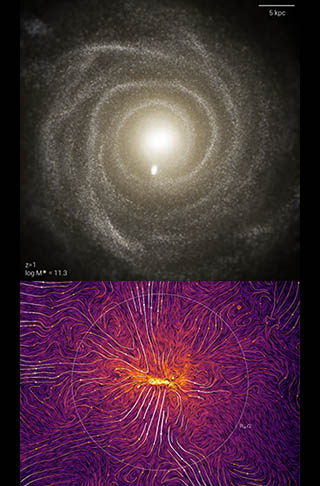
[arXiv] We present the new TNG50 cosmological, magnetohydrodynamical simulation -- the third and final volume of the IllustrisTNG project. This simulation occupies a unique combination of large volume and high resolution, with a 50 Mpc box sampled by 21603 gas cells (baryon mass of 8x104 solar masses). The median resolved galaxies with M* > 107 solar masses. Herein we show first results from TNG50, focusing on galactic outflows driven by supernovae as well as supermassive black hole feedback.
We find that the outflow mass loading is a non-monotonic function of galaxy stellar mass, turning over and rising rapidly above 1010.5 solar masses due to the action of the central black hole (BH). Outflow velocity increases with stellar mass, and at fixed stellar mass, outflows are faster at higher redshift. The phase structure of galactic winds is complex, and we demonstrate that the TNG model can produce high velocity, multi-phase outflows which include cool, dense components. These outflows reach speeds in excess of 3000 km/s with an ejective, BH-driven origin. Critically, we show how the relative simplicity of model inputs (and scalings) at the injection scale produces complex behavior at galactic and halo scales. For example, despite isotropic wind launching, outflows exhibit natural collimation and an emergent bipolarity. We present a correlation between outflow velocity and offset from the star-forming main sequence -- galaxies above the SFMS drive faster outflows, although this correlation inverts at high mass with the onset of quenching, whereby low luminosity, slowly accreting, massive black holes drive the strongest outflows.
First results from the IllustrisTNG simulations: the galaxy color bimodality
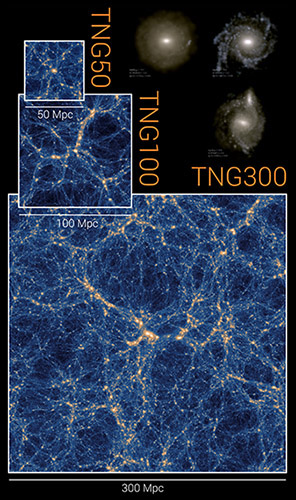
[arXiv] We introduce the first two simulations of the IllustrisTNG project, a next generation of cosmological magnetohydrodynamical simulations, focusing on the optical colors of galaxies. We explore TNG100, a rerun of the original Illustris box (~100 Mpc) and TNG300, which includes 2x25003 resolution elements in a volume twenty times larger (~300 Mpc); both are run using the new TNG model for galaxy formation.
Here we present first results on the galaxy color bimodality at low redshift. Accounting for the attenuation of stellar light by dust, we compare the simulated (g-r) colors of 109 < M*/Msun < 1012.5 galaxies to the observed distribution from the Sloan Digital Sky Survey (SDSS). We find a striking improvement with respect to the original Illustris simulation, as well as excellent quantitative agreement in comparison to the observations, with a sharp transition in median color from blue to red at a characteristic M* ~ 1010.5 Msun. Investigating the build-up of the color-mass plane and the formation of the red sequence, we demonstrate that the primary driver of galaxy color transition in the TNG model is supermassive blackhole feedback in its low-accretion state. Across the entire population we measure a median color transition timescale dt_green of ~1.6 Gyr, a value which drops for increasingly massive galaxies. We find signatures of the physical process of quenching: at fixed stellar mass, the color of a galaxy correlates with its SFR, age, metallicity, and gas fraction, as well as the magnetic properties of both its interstellar medium and extended gaseous halo. Finally, we measure the amount of stellar mass growth on the red sequence. Galaxies with M* > 1011 Msun which redden at z<1 accumulate on average ~25% of their final z=0 mass post-reddening; at the same time, ~18% of such massive galaxies acquire half or more of their final stellar mass while on the red sequence.
The IllustrisTNG Simulations: Public Data Release
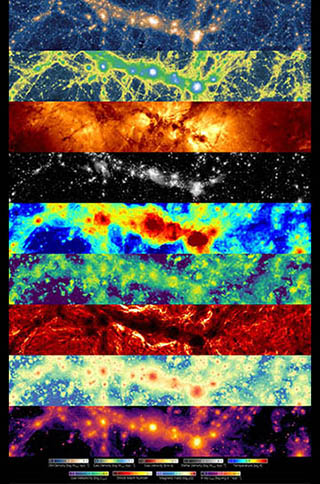
[arXiv] We present the full public release of all data from the TNG100 and TNG300 simulations of the IllustrisTNG project. IllustrisTNG is a suite of large volume, cosmological, gravo-magnetohydrodynamical simulations run with the moving-mesh code Arepo. TNG includes a comprehensive model for galaxy formation physics, and each TNG simulation self-consistently solves for the coupled evolution of dark matter, cosmic gas, luminous stars, and supermassive blackholes from early time to the present day, z=0. Each of the flagship runs -- TNG50, TNG100, and TNG300 -- are accompanied by lower-resolution and dark-matter only counterparts, and we discuss scientific and numerical cautions and caveats relevant when using TNG. Full volume snapshots are available at 100 redshifts; halo and subhalo catalogs at each snapshot and merger trees are also released.
The data volume now directly accessible online is ~750 TB, including 1200 full volume snapshots and ~80,000 high time-resolution subbox snapshots. This will increase to ~1.1 PB with the future release of TNG50. Data access and analysis examples are available in IDL, Python, and Matlab. We describe improvements and new functionality in the web-based API, including on-demand visualization and analysis of galaxies and halos, exploratory plotting of scaling relations and other relationships between galactic and halo properties, and a new JupyterLab interface. This provides an online, browser-based, near-native data analysis platform which supports user computation with fully local access to TNG data, alleviating the need to download large simulated datasets.
3. Zooming in on the CGM and Project GIBLE
Project GIBLE
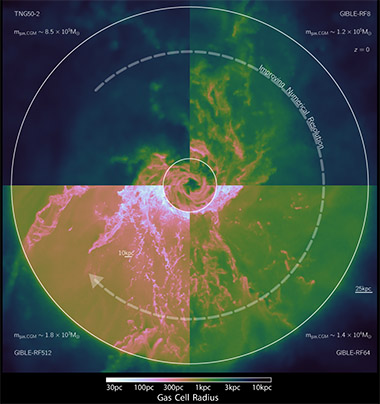
[arxiv] Project GIBLE is a suite of cosmological hydrodynamical simulations of Milky Way-like galaxies, extracted from TNG50 and re-run with a CGM refinement technique to achieve ultra high-resolution in the circumgalactic medium (CGM). This effort is being led by Rahul Ramesh.
The first paper in the series "Zooming in on the circumgalactic medium: resolving small-scale gas structure with the GIBLE cosmological simulations" presents the initial sample of eight galaxies. Using the same galaxy formation model as IllustrisTNG, and the moving-mesh code AREPO, we re-simulate each of these eight galaxies maintaining a resolution equivalent to TNG50-2 (mgas ∼ 8×105 Msun). However, we use our super-Lagrangian refinement scheme to more finely resolve gas in the CGM around these galaxies. Our highest resolution runs achieve 512 times better mass resolution (∼ 103 Msun). This corresponds to a median spatial resolution of ∼ 75 pc at 0.15 R200c, which coarsens with increasing distance to ∼ 700 pc at the virial radius.
We make predictions for the covering fractions of several observational tracers of multi-phase CGM gas: HI, MgII, CIV and OVII. We then study the impact of improved resolution on small scale structure. While the abundance of the smallest cold, dense gas clouds continues to increase with improving resolution, the number of massive clouds is well converged. We conclude by quantifying small scale structure with the velocity structure function and the auto-correlation function of the density field, assessing their resolution dependence. The GIBLE cosmological hydrodynamical simulations enable us to improve resolution in a computationally efficient manner, thereby achieving numerical convergence of a subset of key CGM gas properties and observables.
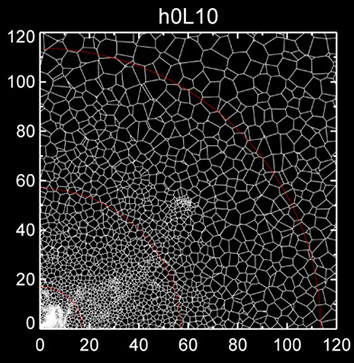
Zooming in on accretion - I. The structure of halo gas
[arXiv] [high-res PDF] We study the properties of gas in and around 10^12 Msun haloes at z=2 using a suite of high-resolution cosmological hydrodynamic 'zoom' simulations. We quantify the thermal and dynamical structure of these gaseous reservoirs in terms of their mean radial distributions and angular variability along different sightlines.
With each halo simulated at three levels of increasing resolution, the highest reaching a baryon mass resolution of ~10,000 solar masses, we study the interaction of filamentary inflow and the quasi-static hot halo atmosphere. We highlight the discrepancy between the spatial resolution available in the halo gas as opposed to within the galaxy itself. Stream morphologies become increasingly complex at higher resolution, with large coherent flows revealing density and temperature structure at progressively smaller scales.
Moreover, multiple gas components co-exist at the same radius within the halo, making radially averaged analyses misleading. This is particularly true where the hot, quasi-static, high entropy halo atmosphere interacts with cold, rapidly inflowing, low entropy accretion. We investigate the process of gas virialization and identify different regimes for the heating of gas as it accretes from the intergalactic medium. Haloes at this mass have a well-defined virial shock, associated with a sharp jump in temperature and entropy at ~1.25 rvir. The presence, radius, and radial width of this boundary feature, however, vary not only from halo to halo, but also as a function of angular direction, covering roughly ~85% of the 4π sphere.
Movies for each halo showing rotations at z=2 and time evolution. (Impatient? watch h0 on Vimeo)
4K resolution (3840x2160) versions: h0, h1, h2, h3, h4, h5, h6, h7. The following links are HD (1080p):
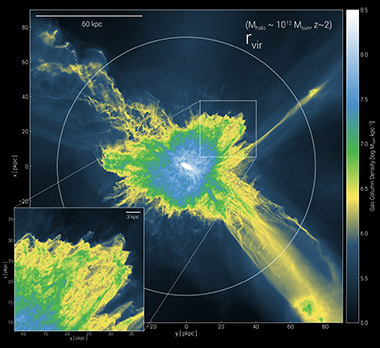
Zooming in on accretion - II. Cold Circumgalactic Gas Simulated with a super-Lagrangian Refinement Scheme
[arxiv] [high-res PDF] In this study we explore the complex multi-phase gas of the circumgalactic medium (CGM) surrounding galaxies. We propose and implement a novel, super-Lagrangian 'CGM zoom' scheme in the moving-mesh code AREPO, which focuses more resolution into the CGM and intentionally lowers resolution in the dense ISM.
We run three cosmological simulations of the same galaxy halo with increasingly comprehensive physical models, ultimately including a treatment of galactic-scale outflows as in the Illustris simulation. Our chosen halo has a total mass of ~1012 Msun at z~2, and we achieve a median gas mass (spatial) resolution of ~2,200 solar masses (~95 parsecs) in the CGM, six-hundred (fourteen) times better than in the Illustris-1 simulation, and higher than any cosmological simulation at this mass scale to date.
We explore the primary channel(s) of cold-phase CGM gas production in this regime. We find that winds substantially enhance the amount of cold gas in the halo, also evidenced in the covering fractions of HI and the equivalent widths of MgII out to large radii, in better agreement with observations than the case without galactic winds. Using a tracer particle analysis to follow the thermodynamic history of gas, we demonstrate how the majority of this cold, dense gas arises due to rapid cooling of the wind material interacting with the hot halo, and how large amounts of cold, ~104 K gas can be produced and persist in galactic halos.
4. Cosmological gas accretion
The impact of feedback on cosmological gas accretion
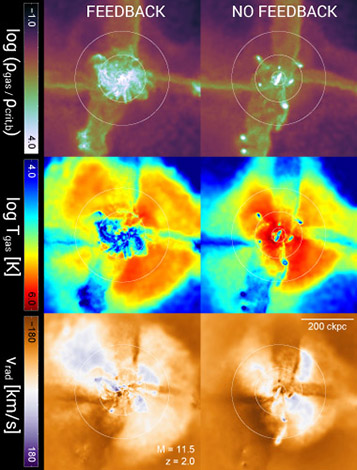
[arXiv] We investigate how the way galaxies acquire their gas across cosmic time in cosmological hydrodynamic simulations is modified by a comprehensive physical model for baryonic feedback processes. To do so, we compare two simulations -- with and without feedback -- both evolved with the moving mesh code AREPO. The feedback runs implement the full physics model of the Illustris simulation project, including star formation driven galactic winds and energetic feedback from supermassive blackholes. We explore:
- (a) the accretion rate of material contributing to the net growth of galaxies and originating directly from the intergalactic medium, finding that feedback strongly suppresses the raw, as well as the net, inflow of this "smooth mode" gas at all redshifts, regardless of the temperature history of newly acquired gas.
- (b) At the virial radius the temperature and radial flux of inflowing gas is largely unaffected at z=2. However, the spherical covering fraction of inflowing gas at 0.25 rvir decreases substantially, from more than 80% to less than 50%, while the rates of both inflow and outflow increase, indicative of recycling across this boundary.
- (c) The fractional contribution of smooth accretion to the total accretion rate is lower in the simulation with feedback, by roughly a factor of two across all redshifts. Moreover, the smooth component of gas with a cold temperature history, is entirely suppressed in the feedback run at z<1.
- (d) The amount of time taken by gas to cross from the virial radius to the galaxy -- the "halo transit time" -- increases in the presence of feedback by a factor of ~2-3, and is notably independent of halo mass. We discuss the implications of this invariance for models of hot halo gas cooling.
Moving mesh cosmology: Tracing cosmological gas accretion
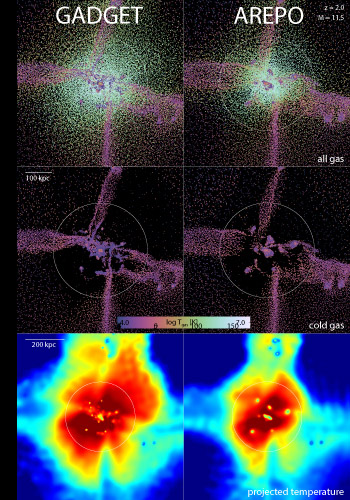
[arXiv] We investigate the nature of gas accretion onto haloes and galaxies at z=2 using cosmological hydrodynamic simulations run with the moving mesh code AREPO. Implementing a Monte Carlo tracer particle scheme to determine the origin and thermodynamic history of accreting gas, we make quantitative comparisons to an otherwise identical simulation run with the smoothed particle hydrodynamics (SPH) code GADGET-3. Contrasting these two numerical approaches, we find significant physical differences in the thermodynamic history of accreted gas in massive haloes above 1010.5 solar masses. In agreement with previous work, GADGET simulations show a cold fraction near unity for galaxies forming in massive haloes, implying that only a small percentage of accreted gas heats to an appreciable fraction of the virial temperature during accretion. The same galaxies in AREPO show a much lower cold fraction, ‹20% in haloes of ~1011 solar masses. This results from a hot gas accretion rate which, at this same halo mass, is an order of magnitude larger than with GADGET, together with a cold accretion rate which is lower by a factor of two. These discrepancies increase for more massive systems, and we explain both trends in terms of numerical inaccuracies with the standard formulation of SPH.
We explore these differences by evaluating several ways of measuring a cold mode of accretion. As in previous work, the maximum past temperature of gas is compared to either a constant threshold value or some fraction of the virial temperature of each parent halo. We find that the relatively sharp transition from cold to hot mode dominated accretion at halo masses of ~1011, is a consequence of the constant temperature criterion, which can only separate virialised gas above some minimum halo mass.
Examining the spatial distribution of accreting gas, we find that the filamentary geometry of accreting gas near the virial radius is a common feature in massive haloes above 1011.5 solar masses. Gas filaments in GADGET, however, tend to remain collimated and flow coherently to small radii, or artificially fragment and form a large number of purely numerical "blobs". These same filamentary gas streams in AREPO show increased heating and disruption at 0.25-0.5 virial radii and contribute to the hot gas accretion rate in a manner distinct from classical cooling flows.
technical projects
scida - scalable data analysis for scientific big data
scida is a Python package (written by Chris Byrohl) for reading and analyzing large scientific data sets. Data access is provided through a hierarchical dictionary-like data structure after a simple load() function. Using the dask library for scalable, parallel and out-of-core computation, all computation requests from a user session are first collected in a task graph. Arbitrary custom analysis, as well as all available dask (array) operations, can be performed. The subsequent computation is executed only upon request, on a target resource (e.g. a HPC cluster, or a private or commercial cloud).

[See github repo for additional information.]
IllustrisTNG Website and 3D Explorer
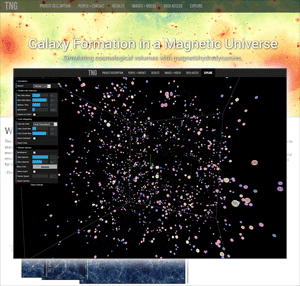
As part of the new TNG simulations, I have developed a public facing website for the project. Again, as a showcase for the collaboration, and in order to describe the motivation, its results and publications, visualizations and movies, and the future planned full data release. In addition to the now classic "Explorer2D", a new "Explorer3D" allows interactive nativation of the full subhalo/galaxy catalogs for all of the simulations using WebGL for browser-based 3D rendering. It is similarly coupled into the Data API, and users can select specific halos to then visualize additional information, e.g. the three dimensional distribution of satellites around massive clusters or merger trees through spacetime.
[See website for additional information.]
Illustris Simulation Website and Data Release
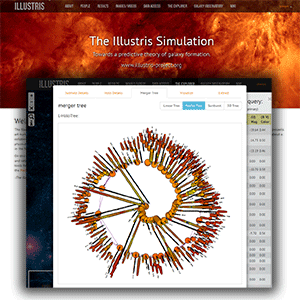
In support of the Illustris simulation project I developed the web presence for the collaboration, as a public showcase, its results, visuals/movies, and the full public data release. It acts as a platform for full download of the data, a comprehensive web-based API, and interactive data exploration and analysis. Current functionality allows dynamic queries over the data products (group catalogs) from the simulation, which are hosted in a relational database. This is coupled to a gigapixel-zoom interface in the Explorer, and a viewer for synthetic/mock stellar light images in the Observatory. Additional features tied into the API include data introspection and extraction from the full dataset (~300TB) hosted on a remote cluster, leveraging a Django-based backend and in-browser visualization of e.g. the merger trees of galaxies, using d3.js and three.js (WebGL). [Data Release Paper]
[See website for additional information.]
Arepo Visualization Toolkit (ArepoVTK)
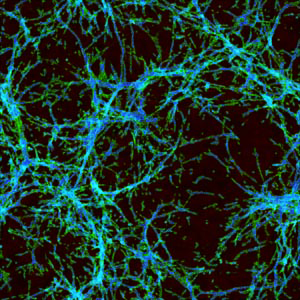
ArepoVTK is designed to produce high quality, presentation-ready visualizations of hydrodynamic simulations run with Arepo. It performs volumetric ray tracing in 3D through linearly reconstructed scalar and vector fields defined on an unstructured Voronoi tessellation of space. It also includes higher order spatial interpolation techniques such as natural neighbor interpolation. Time interpolation between discrete snapshots is currently under investigation. The framework supports multi-dimensional transfer functions to investigate fluid quantities, and explores novel visualization techniques for combining such a volume rendering approach with coincident point particle datasets (both luminous and dark).
[See website for additional information.]
Delaunay Triangulation using Parallel Incremental Extrapolation on GPUs
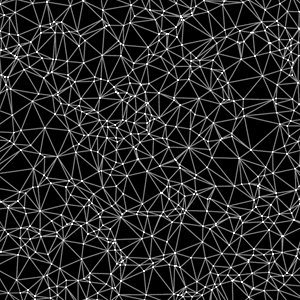
We develop a method for constructing the Delaunay triangulation of a point set which is massively parallel and designed for the many-core architecture of graphical processing units (GPUs). We implement a "parallel incremental extrapolation" algorithm on the plane (2D) under the general position assumption and measure promising speedup with respect to our naive serial implementation.
[See website for additional information.]
Monte Carlo Tracer Particles on a Moving Mesh
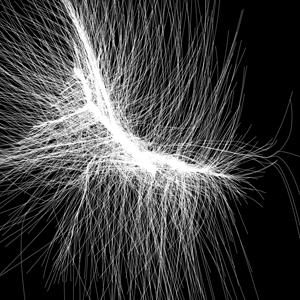
Tracing the origin and (thermo)dynamical history of accreting gas in Eulerian grid codes requires Lagrangian “tracer particles”. The typical approach, whereby massless particles are passively advected by interpolating the local fluid velocity field, is found to exhibit systematic bias in its ability to trace the mass flow. An alternative, probabilistic “Monte Carlo” method associates tracers with parent gas cells and exchanges them based on mass fluxes through each face. The Poisson noise inherent in this approach is minimized with the ALE moving mesh scheme but may be intractable for strictly Eulerian AMR codes.
[See Nelson et al. (2013) and Genel et al. (2013) for additional information.]
Front-Tracking Techniques for Multiphase Viscous Flow
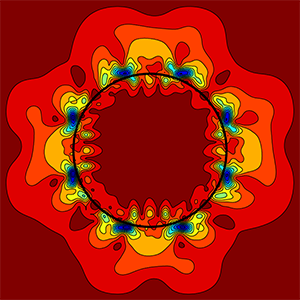
We investigate the numerical simulation of multiphase fluid flow problems in two dimensions. In particular, we implement a front-tracking approach where a number of discrete points represent the free interface between two fluid phases. This boundary is advected in time, and at each timestep we calculate the surface curvature and include a model for surface tension effects. The Lagrangian surface is coupled to a fixed, Cartesian grid mapped to a square domain. The incompressible Navier Stokes equations are used to model continuum fluid flow of both phases, which have different densities and physical viscosities. We use the projection technique to split the second order time update into an advection-diffusion step following by a pressure correction step to enforce the divergence free constraint, while the spatial discretization uses the finite volume approach with staggered, rectangular control volumes for pressure and velocity. We investigate the numerical accuracy and convergence of the curvature calculation, area conservation of a high density drop surrounded by low density air, and the generation of spurious numerical velocities. The approach is then used to simulate the bounce of a water drop off of a rigid boundary. A proof of concept boundary merger algorithm is presented to handle the topological change of two colliding water drops, and extensions to more accurate numerical methods and physical models are discussed.
[See PDF Writeup and Matlab Code.]
[Also related: Continuous Galerkin Navier-Stokes in 2D Writeup.]
visualization
Movies
2D hydrodynamical Riemann test problems
A series of Riemann-like problems in two dimensions. Seven are shown, one after another, each pausing briefly on the initial conditions before initiating. The initial state of each are made up of discontinuities (in pressure, density, and/or velocity), often between four quadrants which meet at a given contact point. The resulting time evolution of the density field is shown in each case -- no analytical solutions to these problems exist. Run with the AREPO moving-mesh code. [1080p download]
Formation of a galaxy supercluster
The formation of the most massive galaxy supercluster in TNG300, starting from 500 million years after the Big Bang and progressing to the present day. By redshift zero, this galaxy cluster has a total mass just exceeding one quintillion times the mass of our sun, and represents one of the most massive objects in the Universe. The visualization depicts physical gas density, from low-density cosmic voids (black) to the highest density central core of the cluster (white). [1080p download] [4K download]
TNG50: Supermassive black hole feedback
The formation of a galaxy cluster in the TNG50 simulation. In the beginning, the visualization shows the motion of cosmic gas. Color encodes velocity from at rest (black) to 1000 km/s (bright red and white). At early times, accretion and infall from the intergalactic medium coallesces in the centers of many small halos. Stellar feedback produces slow galactic winds which gradually push mass outwards, until several central blackholes become sufficiently massive to launch high-velocity outflows to large distance. Past redshift one, we switch to a view of the stellar distribution of this forming protocluster, revealing the process of the hierarchical assembly of structure and its signatures: stellar streams, shells, tidal tails, and merging galaxies. The binary coallesence of the two galactic nuclei occurs at z=0.15, sending spiral waves outwards into the ICL. [1080p download] [4K download]
TNG50: Formation of the Andromeda (M31) Galaxy
The formation of a single large galaxy through time, from high redshift until the present day. This TNG50 galaxy will be similar in mass to Andromeda (M31) by redshift zero. Its progenitor experiences rapid star formation in a turbulent gas reservoir which settles into an ordered disk after z=2. A rather quiet late time assembly history without major mergers allows the galaxy to relax into an equilibrium balance of stellar feedback and gas accretion from its cooling circumgalactic medium. Insets show large-scale dark matter and then gas (lower left), and small-scale stellar and gaseous distributions (lower right). The main panel shows gas density, transitioning to gas metallicity during the brief pause and rotation. [1080p download] [4K download]
Zooming in: the structure of halo gas
The distribution of gas (+ dark matter + stars) in and around a 10^12 Msun halo at z=2 simulated with a high-resolution cosmological hydrodynamic 'zoom'. This is h0L11, see the Research page for movies of the other seven halos. We show gas density, temperature, entropy, and radial velocity on the halo scale (circles are 1.0, 0.5, and 0.15 rvir). Also gas density and stellar density on small scales (circle is 0.15), and gas density and DM density on large scales (circles are 0.5 and 1.0 rvir). [1080p download] [4K download]
The Universe in Gas
"The Universe in Gas" shows a large volume of a simulated universe, 20 Mpc/h on a side, at redshift zero (the present time). Volume rendering highlights iso-surfaces of gas density, temperature, and their relation. Bright peaks in the density reveal galaxies, which are surrounded by their hot halo atmospheres, and interconnected with filaments arising from the large scale structure of the universe. This animation visualizes results from a numerical hydrodynamical simulation of a cosmological volume run with the moving mesh code AREPO. Included are the effects of gas (baryons), dark matter (not shown), as well as stars and black holes (also not shown) and their energetic feedback processes. Made with ArepoVTK. [1080p HD download]
Illustris: Hierarchical "Zoom" into a Galaxy
Continuous zoom-in from the scale of the entire simulation volume (~100 Mpc) to the scale of an individual spiral galaxy (~10 kpc), highlighting the diversity of multi-scale structure, the large dynamic range of the simulation (10^6 per dimension), and the relationship between dark matter, gas, and stars. Made from images extracted from the interactive Illustris Explorer app. [1080p HD download]
Coffee Cup Problem (3D)
An impressive early animation made by V. Springel for the AREPO code was a 2D box within which a moving, curved solid boundary moves in a circular motion, meant to represent a spoon stirring a cup of coffee. We extend this to toy problem to 3D with an importer which creates an initial condition from any STL surface mesh - in this case, a spoon. Volume rendered with ArepoVTK, illuminating the spoon and highlighting density features due to mixing and the development of KH-like instabilities. [1080p HD download]
Cosmological Gas Accretion Trajectories
This animation shows the trajectories of individual gas elements (on the left) and dark matter particles (on the right) which are bound to the same halo at redshift zero, evolving in time from redshift four.
Images
Multi-Scale Cosmic Structure Formation
Images rendered from cosmological simulations of galaxy, halo, and large-scale structure formation, highlighting the morphology, diversity, and dynamics of objects which form in magnetohydrodynamical computations. Combinations of all the matter components of the Universe are shown: gas, dark matter, stars, and supermassive black holes.
Voronoi Meshing
When things go wrong...
ArepoVTK Development Gallery
A scrapbook of sorts of the ongoing development of ArepoVTK. Some extremely simple test meshes exploring different rendering techniques and approaches for transfer functions, as well as mesh visualization. Some galactic disks, face-on and edge-on. Some whole box and zoom-ins from cosmological hydro simulations.
webgl
These WebGL experiments should work on most modern web browsers. Comments welcome!
Interactive Gadget/Arepo Halo Comparison Project (v2)
The interactive Gadget/Arepo halo comparison project is a WebGL experiment that compares the gas distribution around two dark matter halos. Part of the Moving Mesh Cosmology simulations, one halo is taken from a cosmological simulation run with the well-known SPH code GADGET3. The other is a matched object run with the new moving mesh code AREPO. The experiment allows the user to manipulate the view, the fluid quantities which are displayed, and the rendering method. [Launch Now]
Gadget/Arepo Halo Comparison Project (v1)
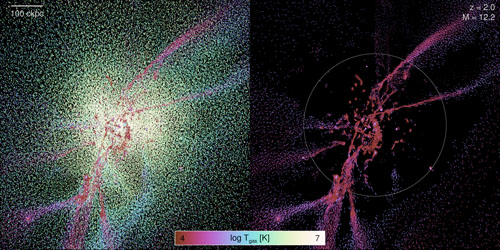
We present a large catalog of several thousand halos extracted from cosmological simulations. Each is shown from three orthogonal views and with different rendering techniques - velocity field scatter plots, SPH kernel projection maps, and a large scale comparison with the dark matter field. A range of halo masses is rendered at each z=0,1,2,3 and individual halos are matched between the two simulations. [Website Depreciated]
Tracing Cosmological Gas Accretion... Through Time
This second experiment visualizes the time evolution of tracer particles as they accrete into a galaxy at low redshift. Their trajectories relative to the evolving halo are animated, while the maximum temperature they obtain between each point is represented by a color mapping. Catmull-Rom splines interpolate between tracer positions at discrete snapshots. The evolving radius and virial temperature of the parent halo are represented by the changing virial sphere. In addition to viewing one instant at time, the radial mode also allows us to move all tracers to the same radius and investigate the time-collapsed geometry and thermal heating. [Launch Now]
Structure of 3D Voronoi Tesellations
We implement the single-pass, shader-based wireframe rendering technique of Bærentzen et al. (2008) in WebGL (no geometry shaders), for the case of arbitrary polygonal faces. A Voronoi mesh is exported as its constituent faces, each having N vertices and requiring N+2 triangles in our approach. The edges and interiors of each face are simultaneously rendered by the fragment shader, using at each pixel the window space distance to the edge of the face. For large meshes, we can "illuminate" only a slab or a radial shell. The geometry can also be "exploded" by radial displacement. With this technique we can render up to ~100k cells (~1mil faces and ~5mil triangles). Stereoscopic 3D support for side-by-side type systems (Oculus Rift, or dual polarized projector setups). [Launch Now]
See also a rendered animation on Vimeo, or download 800x800 or 1920x1080 versions.
Explorer3D: Hierarchical Volume Rendering
The IllustrisTNG 'Explorer3D' interface was originally designed to visualize the hierarchy of structure in cosmological simulations, by representing the N most massive dark matter halos as spheres, size scaling with virial radius, while all smaller halos are represented by points. Users can interactively choice the physical quantites (e.g. virial temperature, halo mass) to use as a color field, and control other options of the visualization.
In v2, we have developed a uniform grid volume renderer, based on a 2-pass method, where the first pass renders the back faces of a cube representing the volume, using the fragment shader to store the world space coordinates of each pixel into an off-screen texture. In the second pass, we render the front faces of the cube, obtaining via difference with the previous coordinates the ray-box intersection and direction. The fragment shader performs the actual volume rendering by marching the ray through the grid of physical quantity, following the emission-absorption radiative transfer equation. Hierarchical grids are pre-computed and packed into a datafile allowing representation at different resolutions (323, 643, 1283, 2563, and 5123). The user defines a transfer function of interest, based on physical properties including gas density, temperature, velocity, and x-ray luminosity. [Launch Now]
cv
Dylan Nelson :: Curriculum Vitae
Albert-Ueberle-Str. 2, 69120, Heidelberg, Germany
dnelson@uni-heidelberg.de
RESEARCH INTERESTS:
- Cosmological Magnetohydrodynamical Simulations, Computational Methods
- Galaxy Formation and Evolution, Galactic Feedback
- Circumgalactic Medium, Gas Accretion and Outflows, Baryon Cycle
- Machine Learning, Synthetic Observations, Forward Modeling of Simulated Galaxy Observables
EDUCATION AND EMPLOYMENT:
Institute for Theoretical Astrophysics (ITA/ZAH), Heidelberg University, Germany
- November 2020 - Present
- Emmy Noether Research Group Leader
Max Planck Institute for Astrophysics (MPA), Munich, Germany
- November 2015 - October 2020
- Postdoctoral Fellow
Harvard University, Cambridge, MA
- September 2009 - May 2015
- Astrophysics PhD
- Secondary Field: Computational Science and Engineering
University of California Berkeley, Berkeley, CA - Graduated 2008
- Triple Major: Physics, Astrophysics, and Mathematics
- Member: National Society of Collegiate Scholars
- Junior Member: American Astronomical Society
- Honors Standing: September 2004 - May 2008
GRANTS:
Please contact me directly for funding details of successful PI and Co-I proposals.
AWARDS AND RECOGNITION:
- Einstein Foundation Berlin – Early Career Award, Finalist (2024)
- European Astronomical Society (EAS) MERAC Prize - Best Early Career Researcher, New Technologies Computational (2023)
- Hector Fellow Academy - Research Career Development Award 2022
- Clarivate Highly Cited Researcher Top 0.1% Award (2021, 2022, and 2023)
- High-Performance Computing Center Stuttgart (HLRS) Golden Spike Award 2019
- Harvard Institute for Applied Computational Science (IACS) Student Fellowship: 2014
- National Science Foundation (NSF) Graduate Research Fellowship: 2009-2011 - Harvard
- John P. Merrill Graduate Fellowship: 2009-2010 - Harvard
- National Institute for Nuclear Physics Italy (INFN) Internship: 2008 – La Sapienza, Rome
- DoE Science Undergraduate Laboratory Internship (SULI) Recipient: 2008 – Fermilab (w/ J. Annis)
- Pomerantz Physics Scholarship Recipient: 2007-08 - UC Berkeley
- NSF Research Experience for Undergraduates (REU): 2007 – IfA, Hawaii (w/ J. Swift, J. Williams)
- NSF Research Experience for Undergraduates (REU): 2006 – MIT Haystack Observatory (w/ S. Doeleman)
PUBLICATIONS (SUMMARY):
- Total: 219 refereed papers (of which 12 are first author, and 32 are second author). [last updated: Mar 2025]
- 29,617 total citations; 4,766 from first-author papers (four first-author papers with 500+ citations, nine with 100+).
- h-index: 69. [ads library]
REFEREED PUBLICATIONS (1st Author):
-
Introducing the TNG-Cluster Simulation: overview and physical properties of the gaseous intracluster medium
A&A (2024) [ads] [arXiv]
-
Resonant scattering of the OVII X-ray emission line in the circumgalactic medium of TNG50 galaxies
MNRAS (2023). [ads] [arXiv]
-
The cold circumgalactic medium in emission: MgII halos in TNG50
MNRAS (2021). [ads] [arXiv]
-
Resolving small-scale cold circumgalactic gas in TNG50
MNRAS (2020). [ads] [arXiv]
-
First Results from the TNG50 Simulation: Galactic outflows driven by supernovae and blackhole feedback
MNRAS (2019b). [ads] [arXiv]
-
The IllustrisTNG Simulations: Public Data Release
CompAC (2019a). [ads] [arXiv]
-
The abundance, distribution, and physical nature of highly ionized oxygen OVI, OVII, and OVIII in
IllustrisTNG
MNRAS (2018b) [ads] [arXiv]
-
First results from the IllustrisTNG simulations: the galaxy color bimodality
MNRAS (2018a) [ads] [arXiv]
-
Zooming in on accretion - I. The structure of halo gas
MNRAS (2016) [ads] [arXiv]
-
The Illustris Simulation: Public Data Release
A&C (2015b) [ads] [arXiv]
-
The impact of feedback on cosmological gas accretion
MNRAS (2015a) [ads] [arXiv]
-
Moving mesh cosmology: Tracing cosmological gas accretion
MNRAS (2013) [ads] [arXiv]
REFEREED PUBLICATIONS (2nd Author):
Significant contributions and directly supervised work.
-
What Drives Cluster Cool-Core Transformations? A Population Level Analysis of TNG-Cluster
A&A submitted (2025) [ads] [arXiv]
-
The abundance and origin of cool gas in galaxy clusters in the TNG-Cluster simulation
A&A submitted (2025) [ads] [arXiv]
-
IllustrisTNG + Cosmic Rays with a Simple Transport Model: from Dwarfs to L* Galaxies
A&A (2025) [ads] [arXiv]
-
The Multi-Scale Multi-Phase Circumgalactic Medium: Observed and Simulated
Saas-Fee Advanced School Lecture Notes (2024) [ads] [arXiv]
-
Introducing cosmosTNG: simulating galaxy formation with constrained realizations of the COSMOS field
A&A (2024) [ads] [arXiv]
-
Zooming in on the CGM with GIBLE: Tracing the Origin and Evolution of Cold Clouds
A&A (2024) [ads] [arXiv]
-
Zooming in on the CGM with GIBLE: the Topology and Draping of Magnetic Fields around Cold Clouds
A&A (2024) [ads] [arXiv]
-
The heart of galaxy clusters: demographics and physical properties of cool-core and non-cool-core halos in TNG-Cluster
A&A (2024) [ads] [arXiv]
-
An Atlas of Gas Motions in the TNG-Cluster Simulation: from Cluster Cores to the Outskirts
A&A (2024) [ads] [arXiv]
-
scida: scalable analysis for scientific big data
JOSS (2023) [ads] [arXiv]
-
Zooming in on the circumgalactic medium: resolving small-scale gas structure with the GIBLE simulations
MNRAS (2023) [ads] [arXiv]
-
Azimuthal Anistropy of Magnetic Fields in the Circumgalactic Medium Driven by Galactic Feedback Processes
MNRAS (2023) [ads] [arXiv]
-
The Circumgalactic Medium of Milky Way-like Galaxies in TNG50 – II: Cold, Dense Gas Clouds and High-Velocity Cloud Analogs
MNRAS (2023) [ads] [arXiv]
-
The cosmic web in Lyman-alpha emission
MNRAS (2023) [ads] [arXiv]
-
Feedback reshapes the baryon distribution in haloes, outskirts, and beyond: the closure radius from dwarfs to massive clusters
MNRAS (2022) [ads] [arXiv]
-
The Circumgalactic Medium of Milky Way-like Galaxies in TNG50 – I: Halo Gas Properties and the Role of SMBH Feedback
MNRAS (2022) [ads] [arXiv]
-
Ionizing photon production and escape fractions during cosmic reionization in the TNG50 simulation
MNRAS (2022) [ads] [arXiv]
-
Towards precise galaxy evolution: a comparison between spectral indices of z~1 galaxies in IllustrisTNG and the LEGA-C survey
ApJ (2021) [ads] [arXiv]
-
X-ray bubbles in the CGM of TNG50 Milky Way- and M31-like galaxies: signposts of supermassive black hole activity
MNRAS (2021) [ads] [arXiv]
-
Characterizing the abundance, properties, and kinematics of the cool CGM of galaxies in absorption with SDSS DR16
MNRAS (2021) [ads] [arXiv]
-
The physical origins and dominant emission mechanisms of Lyman-alpha halos: results from the TNG50 simulation in comparison to MUSE observations
MNRAS (2021) [ads] [arXiv]
-
Predictions for the Angular Dependence of Gas Mass Flow Rate and Metallicity in the Circumgalactic Medium
MNRAS (2020) [ads] [arXiv]
-
Comparing galaxy formation in the L-GALAXIES semi-analytical model and the IllustrisTNG simulations
MNRAS (2020) [ads] [arXiv]
-
The morphology and kinematics of the gaseous circumgalactic medium of Milky Way mass galaxies -- II. comparison of IllustrisTNG and Illustris simulation results
MNRAS (2019) [ads] [arXiv]
-
High redshift JWST predictions from IllustrisTNG: Dust modelling and galaxy luminosity functions
MNRAS (2020) [ads] [arXiv]
-
Separate Universe Simulations with IllustrisTNG: baryonic effects on power spectrum responses and higher-order statistics
MNRAS (2019) [ads] [arXiv]
-
A New Method to Quantify Environment and Model Ram-Pressure Stripping in N-Body Simulations
MNRAS (2019) [ads] [arXiv]
-
First Results from the TNG50 Simulation: The evolution of stellar and gaseous disks across cosmic time
MNRAS (2019) [ads] [arXiv]
-
Zooming in on accretion II. Cold Circumgalactic Gas Simulated with a super-Lagrangian Refinement Scheme
MNRAS (2019) [ads] [arXiv]
-
The Size Evolution of Star-forming and Quenched Galaxies in the IllustrisTNG simulation
MNRAS (2018) [ads] [arXiv]
-
First results from the IllustrisTNG simulations: the stellar mass content of groups and clusters of galaxies
MNRAS (2018) [ads] [arXiv]
-
Clustering of MgII absorption line systems around massive galaxies: a constraint on feedback processes in galaxy formation
MNRAS (2017) [ads] [arXiv]
REFEREED PUBLICATIONS (Co-author):
See ads library for complete publication list.
INVITED AND CONTRIBUTED TALKS:
I have great fun giving highly visual and engaging presentations of our work, sometimes in amazing places like planetarium domes:
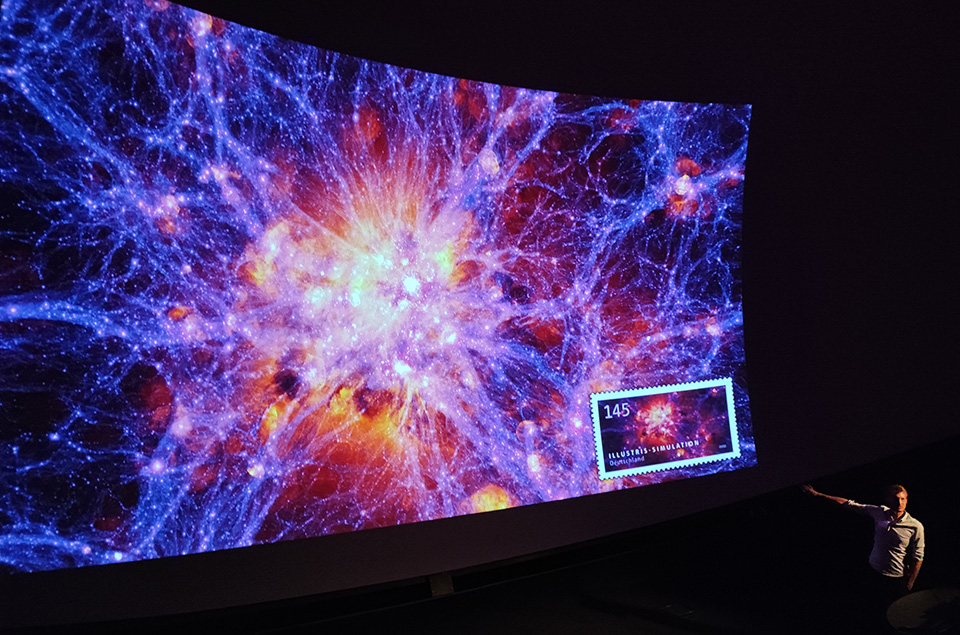
I frequently present at international scientific conferences and invited colloquia, having given ~80 such talks over the past ten years.
A handful of talks I have given at various conferences and workshops are available for viewing online:
- Virtual Universe(s) (Einstein Foundation, Early Career Award 2024 Finalist Presentation)
- Simulating the small-scale CGM (Multiphase Madness: Resolving the CGM in Theory and Observations, Harvard CfA, 2024)
- European Astronomical Society: Plentary Prize Award Talk (EAS Annual Meeting, Krakow, Poland, 2023)
- IllustrisTNG Public Data: Hands-on Tutorial (52nd Saas Fee Advanced Course, Switzerland, 2023)
- Ejective vs preventative: the IllustrisTNG perspective (Epoch of Galaxy Quenching, Cambridge UK, 2022)
- IllustrisTNG: a Universe in a Box (Google/Alphabet X Modeling Talk Series, 2021)
- Signatures of SMBH feedback in the CGM and galaxy population (Royal Astronomical Society Meeting, Virtual, 2021)
- The rise of massive, quiescent galaxies in IllustrisTNG (European Astronomical Society Meeting, Virtual, 2021)
- How does gas flow out of galaxies? (KITP Workshop Keynote Talk, Virtual, 2021)
- Tutorial: Accessing and Analyzing Public IllustrisTNG Data (30 minutes, KITP, 2021)
- Resolving small-scale cold circumgalactic gas in TNG50 (European Astronomical Society Meeting, Virtual, 2020)
- Early results from TNG50: Galactic outflows & structural properties (UC Santa Cruz Galaxy Formation Workshop, 2018)
- Introducing IllustrisTNG: the galaxy color bimodality & clustering (KITP Galaxy-Halo Connection, 2017)
CONFERENCE PROCEEDINGS, WHITE PAPERS, and WORKSHOPS:
- Line Emission Mapper (LEM): Probing the physics of cosmic ecosystems Kraft, R., Markevitch, M., Kilbourne, C. et al. including D. Nelson (2022). NASA X-ray Probe 2023 Mission Concept Proposal. [arxiv]
- Voyage through the Hidden Physics of the Cosmic Web Simionescu, A. et al. including D. Nelson (2019). ESA Voyage 2050 X-ray Mission Concept Proposal. [arxiv]
- Ultraviolet Perspectives on Diffuse Gas in the Largest Cosmic Structures Burchett, J. et al. including D. Nelson (2019). Astro2020 Decadel Survey White Paper. [arxiv]
- The TNG50 Simulation of the IllustrisTNG project: Bridging the Gap Between Large Cosmological Volumes and Resolved Galaxies. Nelson, D., Pillepich, A., Springel, V., Pakmor, R., Hernquist, L. et al. (2018). High Performance Computing in Science and Engineering '18, Springer. [article]
- Computational Astrophysics: Physical Foundations and Numerical Techniques. International Max Planck Research School (IMPRS). Heidelberg, Germany. Sept, 2012.
- AstroInformatics: International UC-High Performance Astrocomputing Center (HIPACC) Summer School. San Diego, CA. July, 2012.
- XSEDE/PRACE Challenges in Computational Sciences: HPC Summer School. Dublin. June, 2012.
- The Morphology and Pattern Speed of Spiral Structure. Nelson, D., D'Onghia, E., Hernquist, L. (2011). Advances in Computational Astrophysics Conference Proceeding, cefalu 2011. [ads]
- Cloud Structure and the Origins of the Stellar Initial Mass Function in rho-Ophiuchus. Nelson, D., Swift, J. J., Williams, J. P. (2007). AAS Meeting 211, Austin, Session #89.12. [ads]
- Effectiveness of the Correlator Field of View Weighting Technique in Source Attenuation. Nelson, D., Doeleman, S. S., Lonsdale, C. J., Oberoi, D., Cappallo, R. J. (2006). AAS Meeting 209, Seattle, Session #85.10. [ads]
TEACHING:
Heidelberg University Lectures:
- Introduction to Computational Physics (Summer 2024, 2025)
- Masters Research Seminar: Galaxy and Black Hole Evolution (Summer 2022)
- Python Programming for Scientists (Winter 2021/22, Summer 2022, Winter 2022/23)
Harvard University Teaching Fellow:
- Astronomy 16 (Undergrad) - Stellar and Planetary Astronomy (Prof. D. Charbonneau)
- Astronomy 17 (Undergrad) - Galactic and Extragalactic Astronomy (Prof. J. Lee)
- Applied Mathematics 274 (Grad) - Computational Fluid Dynamics (Prof. D. Knezevic)
- Computer Science 207 (Grad) - Systems Development for Computational Science (Prof. C. Cecka)
Guest Lecturer:
- 52nd Saas-Fee Advanced Course: The circumgalactic medium across cosmic time (Switzerland, 2023)
- Heidelberg School of Education, Physics Teacher Training and Digitization Meeting (2021)
- Rotman Institute Summer School on the Philosophy of Cosmology (Western Ontario)
- International Max Planck Research School (IMPRS) Advanced Course 'Galaxy Formation' (Garching)
PHD STUDENT SUPERVISION:
- Katrin Lehle (PhD Student, ITA/Heidelberg, graduation in 2026).
- Rahul Ramesh (PhD Student, ITA/Heidelberg, graduated 2025).
- Reza Ayromlou (PhD student, MPA, graduated 2021, co-advised w/ Prof. Simon White, Prof. Guinevere Kauffmann).
- Abhijeet Anand (PhD student, MPA, graduated 2022, co-advised w/ Prof. Guinevere Kauffmann).
- Chris Byrohl (PhD student, MPA, graduated 2021, co-advised w/ Prof. Eiichiro Komatsu).
- Ivan Kostyuk (PhD student, MPA, graduated 2022, co-advised w/ Dr. Benedetta Ciardi).
- Joshua Suresh (PhD student, Harvard CfA, graduated 2017, co-advised w/ Prof. Lars Hernquist, Dr. Shy Genel).
BSC/MSC STUDENT & INTERN SUPERVISION:
- Jan-Hendrik Bergmann (MSc Student, Heidelberg Physics, 2024-present)
- Raphael King (MSc Student, Heidelberg Physics, 2023-present)
- Milan Staffehl (MSc Student, Heidelberg Physics, 2023-2024)
- Nick Andreadis (MSc Student, Heidelberg Physics Fast Track, 2022-2023)
- Finlay Taylor (MSc Student, University of Bath, 2023)
- Jonas Biba (BSc Student, Heidelberg Physics, 2025-present)
- Linn Kantseva (BSc Student, Heidelberg Physics, 2025-present)
- Jonas Spreng (BSc Student, Heidelberg Physics, 2024-2025)
- Ole Wittig (BSc Student, Heidelberg Physics, 2023-2024)
- Emmanouela Gerakaki (BSc Student, Heidelberg Physics, 2023-2024)
- Lucas Schleuss (BSc Student, Heidelberg Physics, 2023-2024)
- Xeno Boecker (BSc Student, Heidelberg Physics, 2022-2023)
- Ema Zavodnik (BSc Projectpraktikum, Heidelberg Physics, 2023)
- Shera Jafaritabar (BSc Projectpraktikum, Heidelberg Physics, 2024)
- Eshna Roy (DAAD-WISE Summer Intern, from IISER Mohali, 2024)
- Qi Guo (Summer Intern, from University of Science and Technology China, 2024)
- Fazian Ahmad (Summer Intern, from TU Berlin, 2023)
- Samridh Dev (Summer Intern, from Grinnell College, 2024)
- Katie Brown (DAAD-RISE Summer Intern, from Western University Canada, 2022)
- Aneesh Baburaj (Summer Intern, from IIS Bangalore, at MPA 2018)
- Summer supervision of Illinois high school students for 6 weeks through the QuarkNet Summer Research Program at Fermilab (w/ Prof. Jim Annis, DoE SULI program)
PRESS, OUTREACH, AND VISUALIZATION:
- Scientific visualizations motivate next-generation astronomical instruments: incorporated into the Lynx Mission Concept Study, the Giant Magellan Telescope (GMT) Science Book, and ESA Voyage 2050. Cover image of Pathways to Discovery in Astronomy and Astrophysics for the 2020s, the decadal survey.
- Physical and digital exhibition development for the new ESO Supernova Planetarium (2018). Redesign of the Illustris Explorer with a public outreach focus, which is now one of the permanent physical exhibits. Helped create 3D printed realizations of dark matter, and other scientifically accurate visuals.
- Collaborated with the National Museum of Emerging Science and Innovation Tokyo (Miraikan) and a visual production studio to produce content for a new 3D movie for their dome theater entitled "The Man from the 9 Dimensions" (Prize Winner, IPS Fulldome Festival 2016, VFX Japan Awards 2017).
- Kavli Foundation interview: Building the Universe Pixel by Pixel.
- Full Dome Visualization @ Boston Museum of Science Hayden Planetarium (AAS Summer 2014)
- Illustris video animations: in our Youtube video (650k views) and Nature Video (950k views)
- Visualization featured on the front page of the New York Times website (16 July 2014).
- Visualizations I have created have been featured on international news, television, and print media including: BBC News, CNN, Der Spiegel, The Guardian, Le Monde, LA Times, Washington Post, Wired, and others.
- Planned and developed the Illustris simulation website and The Explorer interface for interactive visualization.
- Supercomputing 2013 keynote/plenary "Walk-in Video Loop" (3D Coffee, 3D Voronoi)
- Developer of ArepoVTK: visualization of cosmological hydrodynamical simulations for science exploration and public presentation
- Cosmic structure image selected for an official stamp of the Deutsche Post in Germany (Dec 2018)
- Visualizations of cluster growth from TNG50 featured on the Astronomy Picture of the Day (2019).
- Formation of a massive galaxy movie from TNG50 is the second most viewed of all time on the UK Royal Astronomical Society Youtube media channel (2019, 180K views).
- Rendering featured on the cover of Nature (No. 8030, Sep 2024) and a New York Times article (Sep 2024).

